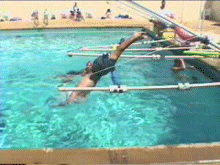

Body Entry (Waist)
Physics
Sir Isaac Newton's Second Saw of Motion:
"A body will accelerate only if it is acted upon by an unbalanced, or resultant force."
Related conclusions:
"The drag or resistance caused by a body moving through water goes up exponentially as you increase your speed. The energy required to move that fast and overcome the drag or resistance is far greater than your body can supply aerobically."
Because water is elastic, the harder you push on it, the harder it pushes back. (Actually, water is visco-elastic, meaning the faster you push on it, the harder it pushes back. But the difference is only important to engineers and physicists!) When the swimmer dives into the water the water is pushed away. It's something like a water balloon.
"It's smarter to take the path of least resistance."
Hip Rotation
Observe how the hip rotation changes the arch of the back during entry. Now concentrate on trying to feel the best momentum as you spear into the water. The angle of entry at this position is probably the most important factor for maintaining the momentum of the dive. It's important that the head not be too far up or down but should be in line with the spine.
Notice how the arch of the back changes at the hips as the body enters the water. The upward arch of the back changes to a downward arch steering the body back up towards the surface so as not to go deep.
This change of direction motion creates a powerful surge.

The whole body should enter through the same hole made by the hands. A tight streamline should be maintained and the use of an explosive kick should be initiated as the knees enter the surface of the water.
If the angle of entry is too steep, the swimmer will loose forward momentum defined by the angle of entry as down instead of forward.